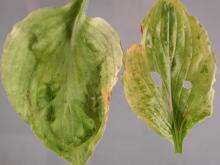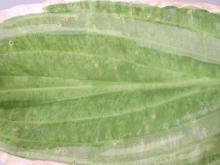See:
Greenhouse Plants, Ornamental - Impatiens Necrotic Spot
Cause Both hosta virus X (HVX) and tomato spotted wilt virus have been found by the OSU Plant Clinic. Hostas may also be infected with impatiens necrotic spot virus (INSV, thrips vectored), (ArMV, nematode vector), tobacco ringspot virus (TSWV, nematode vectored), tomato ringspot virus (ToRSV, nematode vectored arabis mosaic virus), and/or tobacco rattle virus (TRV, nematode vector).
HVX is transmitted by physical or mechanical means where wounded, infected plants are touched followed by touching and wounding healthy plants. Lawnmower injury was given as an example in the original description. It can also be transmitted by vegetative propagation and by seed. Unlike the other viruses, the host range is limited primarily to Hosta spp. Although several cultivars are susceptible there are also several that become infected but show no symptoms. These later cultivars can still spread the virus. Infections of the cultivars Nightlife, Olive Bailey Langdon, and H. sieboldiana cultivars Elegans and Northern Exposure do not go systemic and may be useful to grow.
Symptom TSWV - Ringspots were observed.
HVX - Leaf mottle and line patterns were observed in the OSU Plant Clinic. Mosaic, mottling, chlorotic spotting, interveinal chlorosis between secondary veins and leaf desiccation have also been found in other regions of the country. Additional symptoms may include stunting, dry brown spots, and twisted or deformed leaves. Symptoms may not appear for several years, if at all, for some cultivars. Test kits are available for diagnosis of this virus.
Cultural control
- Minimize mechanic contact between cultivars when tending plantings.
- Knives used to divide hostas and tools used to remove leaves should be regularly disinfected either between plants or between cultivars.
- Remove any infected plants that show symptoms or that test positive for the virus. Train workers to recognize symptoms so possible infections can be caught early.
- Replant with certified virus-tested (and found to be free of all known viruses) plants.
Reference De La Torre, C.M., Qu, F., Redinbaugh, M.G., and Lewandowski, D.J. 2012. Biological and molecular characterization of a U.S. isolate of Hosta virus X. Phytopathology 102:1176-1181.


